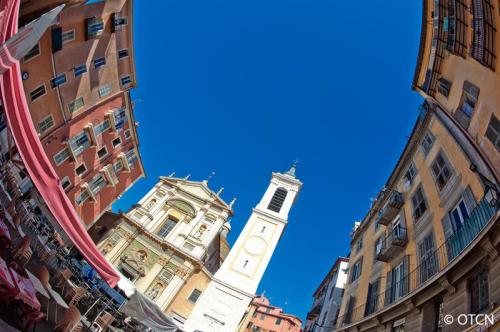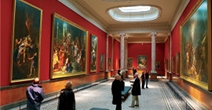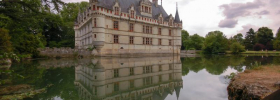 Home
Home- > Tours
- > Provence-Alpes-Côte-d'Azur
- > Alpes-Maritimes
- > Nice
- > Discover the hidden treasures of old nice
Discover the hidden treasures of old nice
| Topic | Sites and museums |
| Departure | NICE (06) |
| Details | Not far from the sea, the old town is one of the liveliest and most popular areas of the city. |
Discover the hidden treasures of Old Nice

Step 1: The shops of Saint Francis of Paola
From the Promenade des Anglais, join the Albert 1st Gardens and then take the St Francis of Paola.
The Saint Francis of Paola long constituted an elegant center where the foreign colony, attending the Cours Saleya, loved to walk to reach the mouth of Spangle. The Saint Francis of Paola is lined with shops offering Nice products (olive oil, candied fruit, rose water, Provencal fabrics ..).
Step 2: The church of Saint Francis of Paola
In the center of St Francis of Paola, discover the church on your left.
The Church of St Francis of Paola has severe facade, due to the transition between the Baroque and Neoclassicism. It was built in the eighteenth century by the brothers Minimes. The adjoining convent was built by Guarino Guarini who drew the plans for the chapel of Mercy. Painting of Hercules Trachel inside.
The church of Saint Francis of Paola is open to the public.
Step 3: Nice Opera
On your right is the Nice Opera.
The Opéra de Nice, historical monument, was built in 1885 by architect François Aune Nice to the site of the ancient theater of Nice created in 1776 by the Marquis de Maccarani. Maccarani the theater, which became the Theatre Royal, destroyed in 1881 by a tragic fire during a performance of Lucia di Lammermoor. Rebuilt in imitation of the Palais Garnier in Paris, it is one of the most beautiful French theaters with its coastline and its ceiling painted by Emmanuel Costa Menton.
Guided tours by appointment.
Step 4: Cours Saleya
At the end of the street, you can discover the Cours Saleya.
"All roads lead to Rome, and in the old town, they lead to court Saleya" wrote the Frenchman
Louis Nucéra. Must visit place in Nice, it is the soul of the old town and its focal point.
The famous flower market place all day its colorful and fragrant multicolored tents under the carpet, while the market for fruit and vegetables leads the Cours Saleya daily. Antique shops and second-hand dealers in the region take possession every Monday to exhibit their antiques, curios, jewelery ... Terraces of restaurants line the course and offer, in ocher environment and light, Nice specialties: stuffed, roasted peppers with olive oil, Bagna cauda, fried zucchini, pissaladières, without forgetting the famous socca, which is eaten as an appetizer or starter.
On summer evenings, walkers enjoy the pleasant arts and crafts market.
Step 5: Palace of the Prefecture
Through the Cours Saleya and discover the Prefecture Palace on your left.
The former Palace of the Dukes of Savoy (1610-1717) was successively Military Hospital, Royal Palace and the Government Palace, before becoming in 1860 the seat of the prefecture of the Alpes Maritimes. For the anecdote, it is in the dining room of the Palace that the Treaty of Nice was signed in February 2001 by the Foreign Ministers of the European Union in the presence of the President of the French Republic and the Prime Minister.
The current building, built and remodeled several times, has an ornate columned facade windows and a beautiful lighted by windows painted gallery. This architecture has earned it a place in particular and partial classification as a historic monument. Guided tours are offered by the Heritage House.
Step 6: Chapel of Mercy
In addition to the Palace of the Prefecture, on your right is the Chapel of Mercy.
Also known as the Brotherhood of Black Penitents. This chapel is a jewel of baroque architecture. It is in 1670 that Theatins brothers mendicant order founded by Gaetano Tiene, settled in Nice. This is Bernardo Antonio Vittone has completed the building in 1739, the site of the former salt warehouses of the King of Sardinia. The chapel has two altars of the Virgin of Mercy, one of Jean Miralheti dated 1430 and the other attributed to Louis Brea in 1500.
Guided tour on Tuesday afternoon by Mr. Prior of the Black Penitents.
Step 7: Chapel of the Holy Shroud / House Caïs Pierlas
Go straight to the bottom of the Cours Saleya.
The Chapel of the Holy Shroud belongs to the Brotherhood of Red Penitents (Catholic lay association canonically). The chapel retains a large table due to the Nice painter Jean Gaspard Baldoino (1660) representing the wrapping of Jesus in the Shroud (shroud of Christ). It takes its name from the fact that the shroud lived in Nice from 1536 to 1543 before his transfer from Chambery to Turin.
The Chapel of the Holy Shroud is available to the public.
Next to the church on your left, you can discover the Caïs Pierlas house where lived the painter Henri Matisse for more than 15 years.
Step 8: Fresco of Adam and Eve
To explore the rest of the route, do not go straight, retrace your steps and follow the first street on the right (the street of the Fish).
The street from the Fish is so named because it led to the fish market. At number 8, look up and watch the first floor, a fresco dated 1584 representing Adam and Eve expelled from Paradise and threatening clubs. It is the only remaining old houses painted testimony. The Nice folk tradition also portrays the sublime fresco as referring to the incessant quarrels of the inhabitants of the building.
At 1 of the Fish Street, behind the austere facade of the Church of the Annunciation, the Baroque Chapel of St. Rita (patron of lost causes), Shrine of popular Nice. It is also one of the oldest churches in Nice. Inside, in the chapel Sainte-Rita, a fresco tells different episodes in the life of the saint. A small notebook, not far from the statue of Saint Rita, you can write your prayer intentions. The Church of St. Rita is publicly available.
Step 9: Church of the Gesu
Right then take the street that has nothing "right".
His name provident a bad translation of "drecha" means direct Italian. He had been so named because it was the most direct way to cross the city by a wall to the other. It was once the largest and most populated of Nice, by noble families.
The beautiful blue facade of the church of the Gesu, also called Saint-Jacques-le-Majeur church, dominates the square that bears his name. It was the first parish founded in the lower town in the fifteenth century. Pre-Baroque style, it was built in 1607 by a wealthy bourgeois Nice, Ponte Cerva on the model of the Church of the Jesuits in Rome.
The Church of the Gesu is publicly available.
Step 10: Palais Lascaris
Go straight down the street Right.
The Palais Lascaris is the only baroque palace open to the public as a municipal museum. In addition to the opulent decoration of its façade and impressive portal, it retains the splendor of the seventeenth and eighteenth century a magnificent staircase covered with a vault penetration and sumptuous ceilings painted by Italian artists. Designed like the Genoese palaces, the ground floor, the basement and courtyard are held for trading and storage of wool and grain. Floors noble honor reserved for apartments, are treated with more elegance. A view on the ground floor pharmacy eighteenth century from a pharmacy in the city of Besancon. Since 2009 it houses a large collection of ancient musical instruments.
Free admission.
To the Palais Lascaris, go to number 13 and look up to your left to see the ball fired by the Turkish fleet in 1543, the seat of Nice where distinguished Catherine Ségurane, heroin Nice.
Step 11: Holy Cross Chapel
After discovering the ball Catherine de Ségurane, follow the street from the Lodge on your right and go up the alley. The Holy Cross Chapel, historical monument, is since 1764 the seat of the Arch-Confraternity of Penitents Blancs. Note on the front pelican opening the abdomen to feed her young, symbol of St. Bonaventure. This chapel is unfortunately closed to the public, except on Tuesdays between 15h and 17h and during Heritage Days.
Step 12: Place Saint François
To join the Saint Francis, go down the street to the Lodge, where you can visit several art galleries, and then continue your way down the street Right.
The Communal Palace, former City of Nice, chaired the Saint Francis and the adjacent former Franciscan monastery. Built in 1580 during the expansion of the upper town, the decor is a bit newer. The great portal dated 1679 is the work of Grigho. Notice the baroque facade and frescos carnival (the left-hand side) that were conducted after the designs of Count Tavigliano, royal engineer Charles Emmanuel III of Savoy. The Communal Palace now houses the Labour Exchange. It is registered as an historic monument.
Place Saint Francis welcomes the fish market Tuesday to Sunday morning.
Step 13: Place Garibaldi
Continue straight path along the street Pairolière. Cross the road and join opposite Piazza Garibaldi.
Designed between 1750 and 1780 as part of major urban development projects of the city under the leadership Turin, Piazza Garibaldi is a model of harmony. Nicolo, Count Robilante, architect Lympia port, and Anthony Spinelli will contribute to its construction completed in 1785. Its current name was given to him in 1870 to honor the great Giuseppe Garibaldi, born in Nice in 1807. It is characterized by four rows of buildings opening onto vaulted arcades, in the best tradition of Turin architecture. Remodeled several times, the elegant facades of the buildings are emblazoned with trompe l'oeil in light green and yellow Nice for parts. The median, which was once a venue for meetings and parties, the statue of Garibaldi, the work of Antoine Etex and Gustave Deloye.
The archaeological crypt of Nice, discovered six meters underground during construction of the tram offers 2000 m2 of medieval and ancient remains surprisingly intact, telling several centuries history of the city. The crypt, recently opened to the public, is comparable to the Louvre. It is accessible from the Garibaldi Square and can be visited by booking with the Heritage Centre.
Step 14: Place Rossetti
To reach the Place Rossetti, retrace your steps and return to the street Pairolière.
It is now one of the busiest shopping streets of Old Nice. There are strings of perugine, the porcheta and salt cod. In the center of the street Pairolière at the intersection, follow the street Collet and Central Street and Mascoinat street.
More than anywhere else, the house has an Italian atmosphere, it is almost in Rome's Trastevere ocher facades, balconies and flowers, fountain, baroque cathedral, outdoor cafes and glaciers occupy the pavement under the cool shade of the parasols. There is also the most famous glacier of the city, more than 90 flavors are available.
Step 15: The Cathedral of St. Reparata
On Place Rossetti, admire the Cathedral of St. Reparata.
The Cathedral of St. Reparata is dedicated to the patron saint, martyred at the age of fifteen, at Caesarea in Palestine, not succumbing to idols. His headless body, placed in a boat drifted from Palestine to be pulled to shore by angels. This is also the religious explanation of the name "Baie des Anges". Holy Reparata cathedral was built in 1650 by architect Jean Nice Andree Guibert. The current facade was restored in 1824 thanks to the generosity of the Knight Honored Rossetti. At the intersection of the transept and the nave stands a magnificent dome drum glazed tile. Restored to its 1972 to 1982 by Guy Ceppa fresco, the Cathedral of St. Reparata has regained its luster and the statues of the first bishops of Nice, the Saints Siagre, Bassus, Pons and Valere.
Historical monument since 1906, is the current seat of dioscèse Nice.
The Cathedral of St. Reparata is open to the public.
Step 16: Place du Palais
To join the Palace Square, past the Cathedral of St. Reparata and continue the street name and turn right into the Rue de la Prefecture and go straight.
This is one of the oldest places in the new part of the old town, overlooking "pre geese" marshland at the mouth of Spangle. She was appointed to the Italian in 1989 for pedestrians and ornate fountains. Around the square are four palaces:
- In the north, the Palace of the Counts of CESSOLE Carlo built by Filippo Juvarra.
- To the east, the solemn Courthouse built in 1890 (for the record, place of escape Albert Spaggiari, author of "Brain of Nice")
- To the south, a building whose facade was "overloaded" in the nineteenth century.
- To the west, the Palais des Torrini barracks Rusca and Clock Tower.
On Saturday, they are markets for old books and used the old postcards, artists and craftsmen who take possession of the place.
Step 17: Place Massena
Continue straight, you walk along the tram line to join the Place Massena.
For other requests or information, be aware that on the Place Massena is an information point this June to September.
South is the fountain of the sun representing characters from Greco-Roman mythology chaired a large marble statue of Apollo over seven meters high.
Accommodation nearby
Latest news on : Discover the hidden treasures of Old Nice
Tourism near
 Visit the city of Nice
Visit the city of Nice - 25 Museum
- 9 Monuments
Tours
 Tour to explore Alpes-Maritimes
Tour to explore Alpes-Maritimes
 A weekend to discover Nice
A weekend to discover Nice
 Villefranche-sur-Mer
Villefranche-sur-Mer
 Saint-laurent-du-var, a town to e discovered
Saint-laurent-du-var, a town to e discovered





































